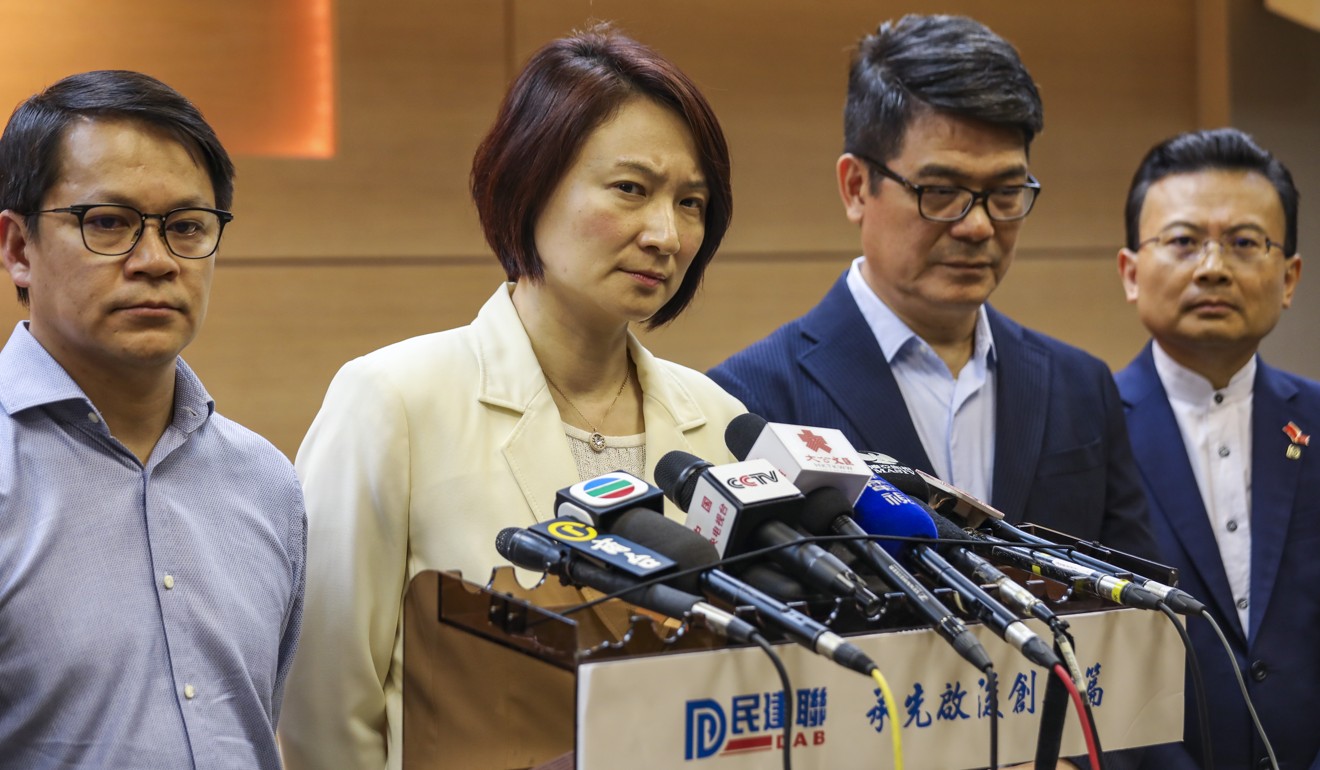Can the Lands Resumption Ordinance offer a way out of Hong Kong’s housing crisis and quell protests?
- Hong Kong’s largest pro-Beijing party has called on the government to seize private developers’ land for public housing
- Some accuse Democratic Alliance for the Betterment and Progress of Hong Kong of trying to win back voters it fears lost ahead of district council elections

A front-page advertisement, placed by Hong Kong’s largest pro-Beijing party in a local newspaper on Wednesday and calling on the government to seize private developers’ land for public housing, set many talking.
Some say the Democratic Alliance for the Betterment and Progress of Hong Kong (DAB) made that move to woo voters ahead of upcoming district council elections, knowing that its popularity has slipped since it took the government’s side in the extradition bill saga that triggered the ongoing protests.
Others say the politicians are helping to divert attention from the civil unrest that has gone on for more than three months and become increasingly violent.
What raised eyebrows, however, was the way mainland China’s state mouthpieces chorused on Friday that unaffordable and inadequate housing was a cause of the protests. They endorsed the DAB suggestion to use the Lands Resumption Ordinance to seize private owners’ land, and urged the city’s big developers to “show their sincerity” and help the government out of the ongoing crisis.
Hong Kong developers are estimated to own a huge land bank of 1,000 hectares of abandoned farmland. If the government seizes 150 hectares of usable land, it would be able to build 170,000 public homes within 10 years.
While Chief Executive Carrie Lam Cheng Yuet-ngor has yet to state her view, the Post looks at what the legislation in the spotlight is about.
What is the Lands Resumption Ordinance?
Dubbed the administration’s “imperial sword”, the law empowers the government to forcibly take back private land for an established public purpose such as public housing, or the development of new towns, or community facilities such as schools, parks, hospitals or welfare service buildings.
Once the government eyes a site, there will be consultation with relevant district councils for all projects before the land is taken back and cleared. Views from public consultations are considered by the chief executive and cabinet in reaching a decision.

Affected landowners are paid compensation, assessed on the open market value of the property, which includes taking into account prices paid for similar property in recent transactions.
For example, the rate for Category A agricultural land – within planned new towns or affected by major projects of “territory-wide significance” – is currently HK$1,348.80 (US$172.47) per square foot.
2. Has the government used this law before?
Yes. The ordinance has been used in building new towns, public housing, and urban redevelopment projects.
Lam said last year that the law had to be used prudently because the Basic Law, Hong Kong’s mini-constitution, protected private property rights.
Private landowners, who may take years to build up their land banks, could also raise legal challenges to government attempts to take back their land.
Indeed, in 2013, the government scaled down its initial land resumption proposal for the planned new town in Kwu Tung and Fanling North, after developers threatened a judicial challenge.
In the end, the government only took private sites zoned for infrastructure, community facilities and public flats.
The developers were given a “partner” role in providing private flats in the area. Those owning land within the new town’s boundary were allowed to build their own projects on sites zoned for private flats and commercial use, subject to conditions.
3. Has government encouraged developers to give up land?
Carrie Lam thinks it is important to encourage developers to unlock their huge land bank of abandoned farmland in order to ease Hong Kong’s severe shortage of land.
Some projects by developers have not been able to clear town planning hurdles, largely due to the lack of infrastructure, including roads and electricity and water supply.

In her policy address last year, Lam unveiled a “Land Sharing Pilot Scheme” through which the government would help such private projects proceed, by resuming land for the required infrastructure.
The scheme allowed the government to raise the development density on such sites and, in return, developers would have to devote 70 per cent of the increased floor space to public housing.
The scheme was expected to be launched in June, but has been postponed amid the anti-government protests.
4. Do other governments take back private land?
Yes. Singapore’s Land Acquisition Act of 1966 enables the government to seize land needed for public projects, with landowners compensated at the prevailing market value.
The law has been used several times. Between 1959 and 1984, about 17,690 hectares – a third of Singapore’s total land area – was acquired. The government said that legislation enabled it to keep down the cost of building homes and industrial premises. Effective land acquisition also resulted in better planning of urban regeneration projects.

The United Kingdom’s Planning and Compulsory Purchase Act, passed in 2004 to amend and repeal previous legislation, has made it easier for local authorities to acquire land compulsorily for redevelopment and major infrastructure projects. Compensation is also pegged to open market value.
5. Should Lam consider the DAB proposal?
Whose idea is this anyway? The DAB is not the first to urge the use of the Lands Resumption Ordinance to take over private land. In January, the Democratic Party tabled a non-binding motion in the legislature calling for more proactive use of the legislation, and DAB actually voted against it.
The Democrats now accuse the DAB of making a U-turn for political purposes, given the looming district council elections in November. They have urged Lam to consider using the law in a significant manner, and not merely apply it to a handful of sites to divert attention from the political crisis and then forget about it.
Some in political circles wonder if the DAB was tipped off by Lam to make its call, paving the way for her to make a policy announcement.
Stanley Wong Yuen-fai, chairman of a former government-appointed task force on land supply, said the government should pursue land resumption and partnership with landowners simultaneously to expedite land supply.
He said the option of land-sharing should always be offered first, to respect private property rights and minimise legal risks.
“If there is a private plot near public transport services, and it is so sizeable that it can hold a public housing estate rather than a single block, the government should first engage the developer for a ‘partnership’ talk. If that bears no fruit, it should resort to land resumption,” Wong said.